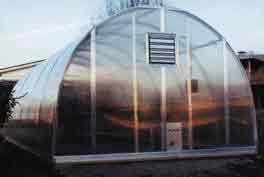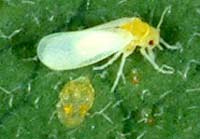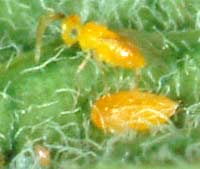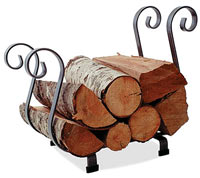 Because of disease-favorable weather in 2004, gray leaf spot and northern leaf blight were potential threats to the 2005 crop. However, dry weather was so prevalent in the 2005 growing season that it helped suppress these and other leaf diseases.
Because of disease-favorable weather in 2004, gray leaf spot and northern leaf blight were potential threats to the 2005 crop. However, dry weather was so prevalent in the 2005 growing season that it helped suppress these and other leaf diseases.

 Because of disease-favorable weather in 2004, gray leaf spot and northern leaf blight were potential threats to the 2005 crop. However, dry weather was so prevalent in the 2005 growing season that it helped suppress these and other leaf diseases.
Because of disease-favorable weather in 2004, gray leaf spot and northern leaf blight were potential threats to the 2005 crop. However, dry weather was so prevalent in the 2005 growing season that it helped suppress these and other leaf diseases.
The fungus that causes gray leaf spot survives in corn leaf residue that was previously infected. The same is true for the fungus that causes northern leaf blight. Since levels of these diseases were so low in 2005, this means that levels of inoculum-the spores that can start the disease process-are lower than normal this winter for both diseases. Thus, the risk from either disease for the 2006 season is probably slightly lower than normal. Producers can take these lower inoculum levels into account when selecting hybrids for next year, and may be safe planting a slightly more susceptible variety than in the past.
However, don't ignore these two diseases completely. The fungal pathogens are both still capable of causing significant damage, especially in fields of continuous corn, where surviving inoculum of these organisms tends to be highest. The spores of both fungi are spread in the wind, so even if your field has a low level of inoculum, neighboring fields may still provide the inoculum needed to lead to a damaging outbreak.
Furthermore, gray leaf spot and northern leaf blight are what are called polycyclic diseases. This means that the fungi that cause these diseases are capable of undergoing repeated infection cycles during the growing season. Thus, if weather conditions in 2006 turn out to be highly favorable for either disease, the disease potentially can build up on a susceptible variety from a small amount of overwintering inoculum into a fierce epidemic.
Since the weather is always an unknown this far in advance, it makes sense to choose hybrids with some resistance to both gray leaf spot and northern leaf blight, especially in fields of continuous corn. Even in rotated fields, having some resistance to these diseases is advisable if they are under conservation tillage, since the corn residue from the 2004 season is still capable of providing inoculum for the 2006 crop.
For information about corn pests, visit
"Insect Management Recommendations".


 The unfortunate news is that there has been a confirmation that the Q biotype of the sweet potato
whitefly (Bemisia tabaci) was found in Kentucky. Nine whiteflies that were sent anonymously
to a lab for testing were all found to be the Q biotype. This is very significant for our greenhouse
producers as this biotype (one of 41 reported Bemisia tabaci biotypes) is very difficult to control
with most of the available insecticides. This biotype is also a very efficient vector of the some
begomoviruses
(see KPN 1075, Oct 24, 2005). B. tabaci bitype Q was first reported in Arizona in
March of this year, since then reports have spread quickly in the US and has been confirmed in 11
additional states (
http://www.mrec.ifas.ufl.edu/LSO/bemisia/positive_states.htm). These Q biotype
whiteflies from Arizona were characterized as being virtually immune to the IGR pyriproxyfen
(Distance), having reduced susceptibility to the insect growth regulator buprofezin (Talus) and the
neonicotinoid insecticides imidacloprid (Marathon or Merit), acetamiprid (TriStar) and thimethoxam
(Flagship).
The unfortunate news is that there has been a confirmation that the Q biotype of the sweet potato
whitefly (Bemisia tabaci) was found in Kentucky. Nine whiteflies that were sent anonymously
to a lab for testing were all found to be the Q biotype. This is very significant for our greenhouse
producers as this biotype (one of 41 reported Bemisia tabaci biotypes) is very difficult to control
with most of the available insecticides. This biotype is also a very efficient vector of the some
begomoviruses
(see KPN 1075, Oct 24, 2005). B. tabaci bitype Q was first reported in Arizona in
March of this year, since then reports have spread quickly in the US and has been confirmed in 11
additional states (
http://www.mrec.ifas.ufl.edu/LSO/bemisia/positive_states.htm). These Q biotype
whiteflies from Arizona were characterized as being virtually immune to the IGR pyriproxyfen
(Distance), having reduced susceptibility to the insect growth regulator buprofezin (Talus) and the
neonicotinoid insecticides imidacloprid (Marathon or Merit), acetamiprid (TriStar) and thimethoxam
(Flagship).
We continue to strongly encourage all greenhouse growers to regularly monitor their plants for
whiteflies as well as other greenhouse pests and diseases. Yellow sticky cards remain one of the
more effective monitoring tools for adult whiteflies, aphids, thrips, and fungus gnats. Plants need
to be examined regularly (at least weekly). As the immature stages are found on the undersides of
leaves, this is where efforts should be focused. Usually, these are the leaves that are one to four
weeks in age. It is relatively easy to identify B. tabaci nymphs by microscope, but the
biotypes can only be identified through laboratory analysis.
 Some of the Bemisia tabaci samples we have been collecting have been heavily parasitized
(30percent or more) by Eretmocerus emericus. This is a commercially available wasp that is
used to manage B. tabaci.
Some of the Bemisia tabaci samples we have been collecting have been heavily parasitized
(30percent or more) by Eretmocerus emericus. This is a commercially available wasp that is
used to manage B. tabaci.
What should you do if whiteflies are not controlled with your typical spray program? First, having a whitefly problem does not necessarily mean you have the Q biotype of B. tabaci. Not all whiteflies are the same, we have been battling greenhouse whiteflies and sweet potato whiteflies for many years. The basics of whitefly control, including cultural and biological tactics, were covered in the KPN 1075, Oct 24, 2005. What are some of the common pitfalls that can lead to poor whitefly control? Here's a list:
It will always be easier to manage a whitefly problem at the onset rather than wait until large numbers are present. With the Q biotype, it is virtually impossible to control a large infestation, so early detection is critical. Regular scouting of the plants is necessary to 1) catch a developing problem before it is a serious problem, 2) when whiteflies are found and controls applied, scouting will monitor the effectiveness of the sprays.
If the whitefly problem seems very unusual, you may want to contact your county extension agent to arrange to have the whiteflies identified.


County Extension Agents make good use of University of Kentucky Plant Pathology Department tree disease diagnostic services offered through the Plant Disease Diagnostic Laboratory (PDDL) and the plant pathology Digital Consulting System (DCS). In order to obtain an accurate diagnosis it is important to provide the best information and sample possible so that the diagnosticians have the best chance of success.
I was reminded of a tree disease diagnosis mnemonic (the first letter m in mnemonic is silent) written by a diagnostician I once met in England. Mnemonic, named after Mnemosyne, Greek goddess of memory, would describe a device used assist the memory. The following tree diagnosis mnemonic found in the book Diagnosis of ill-health in trees by R.G. Strouts and T.G. Winter and published by the Forestry Commission in Britain, might be useful to Extension Agents, arborists, and landscape professionals.
D = Distribution of damage - describe how the damage is distributed on several levels, e.g., within the tree, within the landscape, and within the community.
I = Identity of tree - knowing the kind of tree affected immediately narrows the range of possible diseases.
S = Site type, condition, and changes - learn about soil factors such as soil type and pH, and especially disturbances during the previous five years which would cut roots or compact soils.
E = Environmental conditions and other changes such as weather and treatments applied - treatments made to the tree or unusual weather events such as drought during the previous two years would be relevant.
A = Age of tree now and/or at planting - this information tells how well a tree is established; transplant shock can last for many years and sometimes longer if the tree was planted too deep.
S = Symptoms - many tree disorders have distinctive symptoms; know when you know that an abnormality is present, and know when a symptom is within the normal range for that species.
E = Extraneous matter such as fungal signs, insects, exudates, and odors - fungal or bacterial signs often provide evidence that confirms tree disease.
D = Discolored wood, dead bark - check by cutting into the affected branch for cankers and characteristic wood staining caused by vascular wilt disease.
T = Time of onset of damage and time of disease progression - try to determine if the disease is progressive, recurring, or ephemeral; tree growth rates may provide a clue to how long a tree problem has been active.
R = Root conditions - don't forget to examine the roots for decay and determine if the conditions where they grow such as wet or dry soil is suitable for good health.
E = Evidence - review what has been observed, and if data are missing, try to ask more questions or collect more sample before making a preliminary diagnosis.
E = Extra evidence - identifying some diseases requires laboratory expertise; seek help through the DCS or the PDDL, providing the diagnosticians with the evidence you have already obtained.


 This is the season when many homeowners begin to burn firewood. Firewood is a source of warmth and comfort, but can also be a way for pests to enter homes. Most pests living in firewood pose no harm to people, furniture, or to the structure. Nonetheless, homeowners often become concerned when insects emerge from wood that is brought indoors, and crawl or fly about the house.
This is the season when many homeowners begin to burn firewood. Firewood is a source of warmth and comfort, but can also be a way for pests to enter homes. Most pests living in firewood pose no harm to people, furniture, or to the structure. Nonetheless, homeowners often become concerned when insects emerge from wood that is brought indoors, and crawl or fly about the house.
Several types of pests dwell within firewood. Termites, wood boring beetles, and carpenter ants often tunnel and feed within the logs, but upon emergence, usually will not infest structural wood or furniture inside the home. Other kinds of pests hide or overwinter beneath the bark. Examples include centipedes, ground beetles, sowbugs, pillbugs, spiders, scorpions and wood cockroaches. Typically, these pests emerge within a few days or weeks of the wood being brought indoors. For the most part, they are harmless other than by their presence.
Preventing Firewood Pests
Control of firewood pests is best accomplished by management of the firewood itself. Spraying/dousing the wood with insecticides is not necessary, effective, nor recommended, and could produce harmful vapors when the wood is burned. A better plan is to:


BASF Corporation released the approved label for Forum 500SC on November 18. Forum is the long-awaited liquid formulation (suspension concentrate) of dimethomorph, also known as Acrobat 50W. Like Acrobat, Forum is registered for control of downy mildew on bulb vegetables, cucurbits, fruiting vegetables, leafy brassica greens, and lettuce; late blight of potato and tomato; Phytophthora blight of cucurbits and pepper; and blue mold of tobacco.
Use restrictions and application instructions are the same for Forum as for Acrobat. Dimethomorph is classified as a Group 15 fungicide by the Fungicide Resistance Action Committee (FRAC) and the U.S. EPA, and affects the synthesis of fungal cell walls by attacking a specific target site. Therefore, there is a moderate-to-high risk of developing resistance in pathogen populations if dimethomorph is used improperly. Forum must be applied as a tank-mix with a fungicide that has a mode of action that is different than that of dimethomorph. Depending upon the crop, these products include mancozeb (Dithane, Manzate), maneb (Maneb, Manex) chlorothalonil (Bravo, Equus, Echo), and fixed coppers. See the product label for a complete set of instructions, precautions, and use directions (www.cdms.net/ldat/ld79H000.pdf).
The U.S. EPA recently approved a 24(c) special local need (SLN) registration that permits the use of Dithane DF Rainshield on tobacco in Kentucky. This is a continuation of the 24(c) for Dithane that will expire in December, 2005, and is valid through December 31, 2008.
The supplemental label (www.cdms.net/ldat/ld5U2002.pdf) permits the use of Dithane on tobacco transplants (outdoor beds and float systems) and field-grown tobacco to control blue mold, anthracnose, and damping off. See the product label for detailed use instructions and precautions.
The new Baythroid label has just been released by the EPA and includes a number of new crop groupings. These new crop groupings include additional uses on some vegetable and fruit crops. However, these changes will not appear in the 2006 recommendations because they have come so late and the fruit and vegetable recommendations have already gone to the printer.
New fruit uses permitted on the Baythroid label include: apples and pears (pome fruit group with a 7 day PHI); peaches, cherries, and plum (stone fruit group with a 7 day PHI); and grapes (3 day PHI). This is a pyrethroid insecticide, IRAC group 3, with broad spectrum control with a number of pests on the label.
New vegetable uses on the Baythroid label include: dry beans and peas (7 day PHI); cucumbers, melons, squash, pumpkins and watermelon (cucurbit group with a 0 day PHI); additional leafy greens including spinach and turnip greens (0 day PHI); additional root crops including garden beets, parsnips, and turnips (0 day PHI); and sweet potatoes (0 day PHI). A large number of pests are included for each of these new uses.


Recent samples in the Diagnostic Laboratory have included purple seed stain on soybean; scurf on sweet potato; Pythium root rot on poinsettia; pink snow mold on bentgrass; Bipolaris leaf spot on fescue; black root rot on holly; Hypoxylon canker, Armillaria root rot and wood decay on hickory; Rhizosphaera needle cast and drought stress on blue spruce; white pine decline; and tar spot on maple.


View Princeton trap counts for the entire 2005 season at - http://www.uky.edu/Ag/IPMPrinceton/Counts/2005trapsfp.htm
Fulton County trap counts are available at -http://ces.ca.uky.edu/fulton/anr/Insect%20Counts.htm
For information on trap counts in southern Illinois visit the Hines Report at - http://www.ipm.uiuc.edu/pubs/hines_report/comments.html The Hines Report is posted weekly by Ron Hines, Senior Research Specialist, at the University of Illinois Dixon Springs Agricultural Center.
NOTE: Trade names are used to simplify the information presented in this newsletter. No endorsement by the Cooperative Extension Service is intended, nor is criticism implied of similar products that are not named.
Lee Townsend
Extension Entomologist